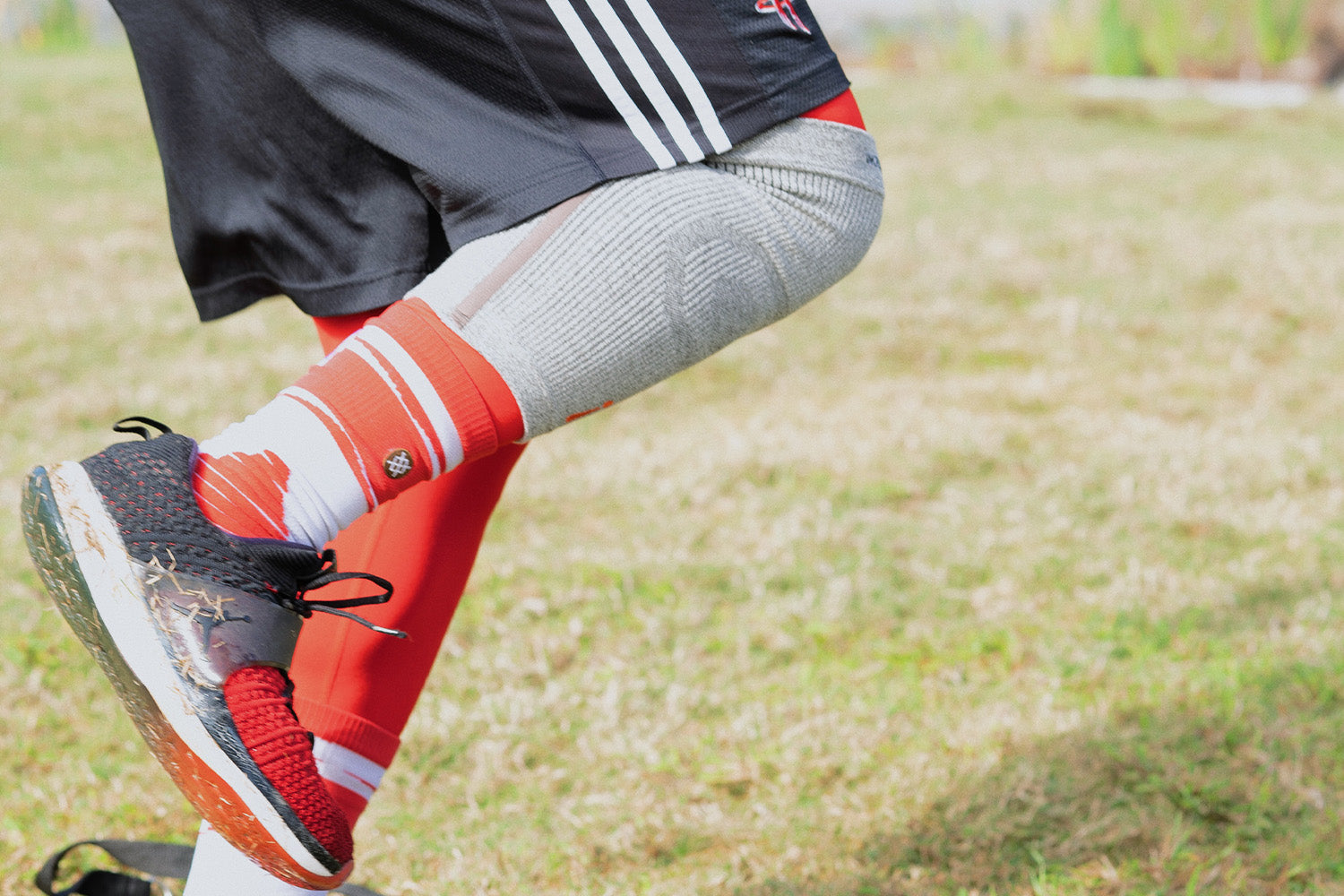Medically Reviewed By | Dr. Kate Panawash, PT, NCS, DPT
Your recovery period doesn’t always have to be rest. Resting is essential, but a light run might be a great addition to your training routine. Many advanced runners who run more than a few times a week benefit from including a recovery run in their training program to support their progress. So is it a good idea for you?
At Incrediwear, we are happy to provide you with everything you need to know about recovery runs, including how to use them and why they make such a great addition to your training routine.
What Is a Recovery Run?
A recovery run is an additional run in your routine designed to support your recovery outside of a longer-distance, higher-intensity run. The key to a recovery run is that it is meant to be low-intensity and not supposed to overexert your body.
During a recovery run, you shouldn’t focus on your pace, time, or distance. Instead, it is best to focus on just taking it easy. “If you track your heart rate, aim for these recovery runs to fall in the 60-70% of your max heart rate, also sometimes called zone 2,” notes Katelyn Panawash, Doctor of Physical Therapy (DPT) and Board Certified Neurologic Clinical Specialist (NCS).
A recovery run is most beneficial within 24 hours of a longer, more intense run. This helps to boost blood flow and remove the buildup of lactic acid in your muscles.
What Are the Benefits of a Recovery Run?
A recovery run is more than just an easy exercise you do. Incorporating recovery runs in your training routine can offer many potential benefits that make the extra effort worthwhile.
When done properly, a recovery run can have several effects.
Enhances Blood Flow
The biggest benefit of a recovery run is that it helps your blood flow to your muscles throughout your body. Blood flow is vital to the proper recovery of your muscles. After intense runs, your muscles generate natural waste from cell respiration and experience lactic acid build-up.
These functions are generally the causes of muscle fatigue and soreness, and it can take several days for the body to cleanse the buildup and provide relief.
However, when you go on a recovery run, your blood flow to these areas increases and moves the cell waste and lactic acid out of your muscles much more quickly. As a result, you can speed up your recovery period by adding a shorter, easier run after your long-distance runs. “It also doesn't need to be a run. Other options include walking, biking, and swimming — these are just some examples of other activities that provide the same enhanced blow flow benefits,” highlights Panawash.
Improves Your Running
Running with a goal in mind is good, but it can also take your mind off of the art of running in itself. A recovery run does away with the time and distance goals, allowing you to focus less on running as fast as possible and more on just running.
When running without trying to beat a personal record, you can pay more attention to the process, giving special attention to your breathing, stride, and overall form. By being more mindful about your running, you can boost your technique and gain takeaways to apply when you pick the intensity back up. You will likely even enjoy running more when you break it down to its roots.
Supports Your Health
Your mindset when running can make all the difference in the recovery process. It can even affect your brain's chemical production. Intense workouts can lead to excess cortisol production, the same hormone released in times of stress.
Excess cortisol production can lead to various undesired effects, like gaining belly fat and a suppressed immune system. However, embracing the ease of a low-intensity run can help you keep your cortisol levels low and raise your dopamine levels instead.
Dopamine is not only supportive in helping your muscle recovery process, but it is also great for your mental health, helping to boost your mood.
Advances Your Training
Of course, the more you run, the closer you get to your goals, especially if you are training for a longer run, like a 10K or a half marathon. However, the last thing you want to do is overexert yourself before the big day.
A recovery run helps you get more miles in for your training program without adding extra stress to your body and risking overdoing it.
Boosts Your Motivation
Resting is an integral part of any training program, but when you have to take a day off, it can feel like you are killing your momentum. Even worse, for some people, taking one day off can lead to multiple days off.
Fortunately, a recovery run can help. Scheduling a recovery run can allow you to walk the line between progressing forward and taking time to rest.
They are also great for people who hate taking days off. If you are the type that wants to run as often as possible, then incorporate recovery runs into your schedule. A recovery run offers benefits without the excessive strain on your body from a normal workout.
How To Include a Recovery Run in Your Training
As demonstrated by its multiple potential benefits, a recovery run is an excellent tool to support your training program. However, if done incorrectly, it can leave you feeling more exhausted than recovered.
To use a recovery run properly and use it to enhance your training program, you should be mindful of a few steps.
Find the Sweet Spot
Finding the right length for the most benefits is key to a recovery run. Everyone is different, so the best length depends on your skill level and experience, but the key is that it shouldn’t be difficult or strenuous.
Generally, a good recovery run length is between 20 and 45 minutes or between two and five miles. If you are a skilled long-distance runner, you may want to aim for a longer recovery run.
On the other hand, if you are a more recreational runner, you probably want to aim closer to two miles or 20 minutes. Whatever the length of run that you choose, what matters is that it is easy for you. After all, overdoing it defeats the purpose.
Know When To Use It
Recovery runs are an excellent strategy for supporting some training programs, especially high-intensity ones. However, you don’t need them to be an everyday addition. Recovery runs are most helpful for runners who run more than three to four times per week. Otherwise, it is best to just stick to a regular running schedule.
Make sure to schedule your recovery runs properly. Using them within 24 hours of a more intense run is best, but normally not less than eight hours apart. A popular strategy for longer distance or advanced runners to perform longer training runs in the morning and recovery runs in the evening.
Remember, if you include recovery runs too often, they might be counterproductive. Rest is still important for recovery too. If you feel like your legs are tired or worn out, or you might have tweaked a muscle, a recovery run is no substitute for proper rest.
Keep It Light
The biggest key to a recovery run is using it for its intended purpose. Don’t worry about keeping a certain pace or pushing yourself to reach a certain mile marker.
Remember that recovery runs are not about working toward a milestone. If you find yourself trying to speed it up or push a little harder, remind yourself to slow down — it will help you make the most of the recovery time. Most importantly, listen to your body. “If you like to listen to music when you run, try switching up the genres or songs to ones that have lower rates of beets per minute (BPM). Try less than 140 BPM, as this may naturally help you maintain a slower pace,” notes Panawash.
Remember the Goal
When you are a dedicated runner, it can be easy for your mindset to shift to pushing yourself every time. Still, it’s important to remember not to turn a recovery run into a stressful one.
Make the most of your recovery run by treating it like a light jog. Consider listening to your favorite songs, playing slower music, or running through a more scenic location. All these things can help you keep the concept of “intensity” out of it. Do whatever you have to do to remind yourself that it’s not the time to overexert yourself.
Have the Right Gear
It helps to have the right recovery gear when including a recovery run in your training schedule. For example, using Incrediwear sleeves and braces can help you double down on the benefit of increasing blood flow to your muscles.
Incrediwear products use semiconductor technology to activate ions in your muscles, stimulating blood flow, oxygen, and nutrient transfer to your target muscles.
Incrediwear offers many great options for runners, from hip braces to knee sleeves. Whatever muscle you want to target, Incrediwear allows you to optimize the recovery process and have your muscles working efficiently to maximize the results of your training regimen.
Boost Your Recovery Time With Incrediwear
Adding a recovery run to your routine is an excellent approach to supporting your overall training goals. Recovering faster helps you get toward your goals quicker. Having the right tools along the way makes it even easier.
As you look to maximize your recovery and minimize your time away from running, turn to Incrediwear for support. Incrediwear products provide a wide range of benefits, from helping your muscles reach peak performance during a workout to allowing them to get additional blood flow during rest periods.
Explore our complete collection of products to see how Incrediwear can advance your workout.
Sources:
6 Types of Metabolic Damage Caused by High-intensity Workouts | ACE Fitness
Exercise and circulating cortisol levels: the intensity threshold effect | PMC
Read more

Are you seeking exhilarating experiences? Obstacle Course Races (OCRs) have surged in popularity, offering thrilling fitness challenges for participants of various fitness levels. OCRs are beloved...

Medically Reviewed By | Dr. Kate Panawash, PT, NCS, DPT You might be hurting your training progress without even realizing it. We all want to get the most progress from our workouts and maximize ou...






Leave a comment
All comments are moderated before being published.
This site is protected by hCaptcha and the hCaptcha Privacy Policy and Terms of Service apply.